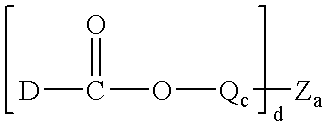Polyether-based dental impression material curable by metathesis reaction
a polyether-based, dental impression technology, applied in the direction of impression caps, plastic/resin/waxes insulators, dental prosthetics, etc., can solve the problems of large polymerization shrinkage, high water uptake in service, formation of oxygen-inhibited layers on the surface, etc., to improve flexibility, taste and smell.
- Summary
- Abstract
- Description
- Claims
- Application Information
AI Technical Summary
Benefits of technology
Problems solved by technology
Method used
Image
Examples
examples
[0068] A dental impression material in accordance with the present invention is set forth in Table 1, wherein the material was made from a two-part composition with a base paste:catalyst paste ratio of 5:1.
TABLE 1PartsBaseUPE norbornenecarboxylate129.9Alkoxy-SPE norbornenecarboxylate210.9CITROFLEX ® A4 plasticizer (Morflex)13.6Siloxane norbornenecarboxylate31.6HDK ® N20P Hydrophilic Fumed Silica (Wacker Silicones)5WINNOFIL ® SPM coated Calcium carbonate (Solvay)39CatalystCITROFLEX ® A4 plasticizer (Morflex)51.86AEROSIL ® R202 Hydrophobic Fumed Silica (Degussa)15TALCRON ® MP 30-36 Talc (Specialty Minerals)33Ruthenium carbene complex 3-1 (1.4 mg / g)0.14
1Compound 3d as disclosed in U.S. Patent Application No. 11 / 276,270.
2Produced by the following method: 1198.1 g of an EO-PO, EO tipped, polyether diol (Bayer, MULTRANOL ® 9111, MW 4000, 800 cps) and 128.9 g of HPNBC were placed in a jacketed 2 L reactor under a nitrogen atmosphere. It was stripped in vacuum at 100° C. for 1 hour with ...
PUM
| Property | Measurement | Unit |
|---|---|---|
| Time | aaaaa | aaaaa |
| Time | aaaaa | aaaaa |
| Time | aaaaa | aaaaa |
Abstract
Description
Claims
Application Information
 Login to View More
Login to View More - R&D
- Intellectual Property
- Life Sciences
- Materials
- Tech Scout
- Unparalleled Data Quality
- Higher Quality Content
- 60% Fewer Hallucinations
Browse by: Latest US Patents, China's latest patents, Technical Efficacy Thesaurus, Application Domain, Technology Topic, Popular Technical Reports.
© 2025 PatSnap. All rights reserved.Legal|Privacy policy|Modern Slavery Act Transparency Statement|Sitemap|About US| Contact US: help@patsnap.com



